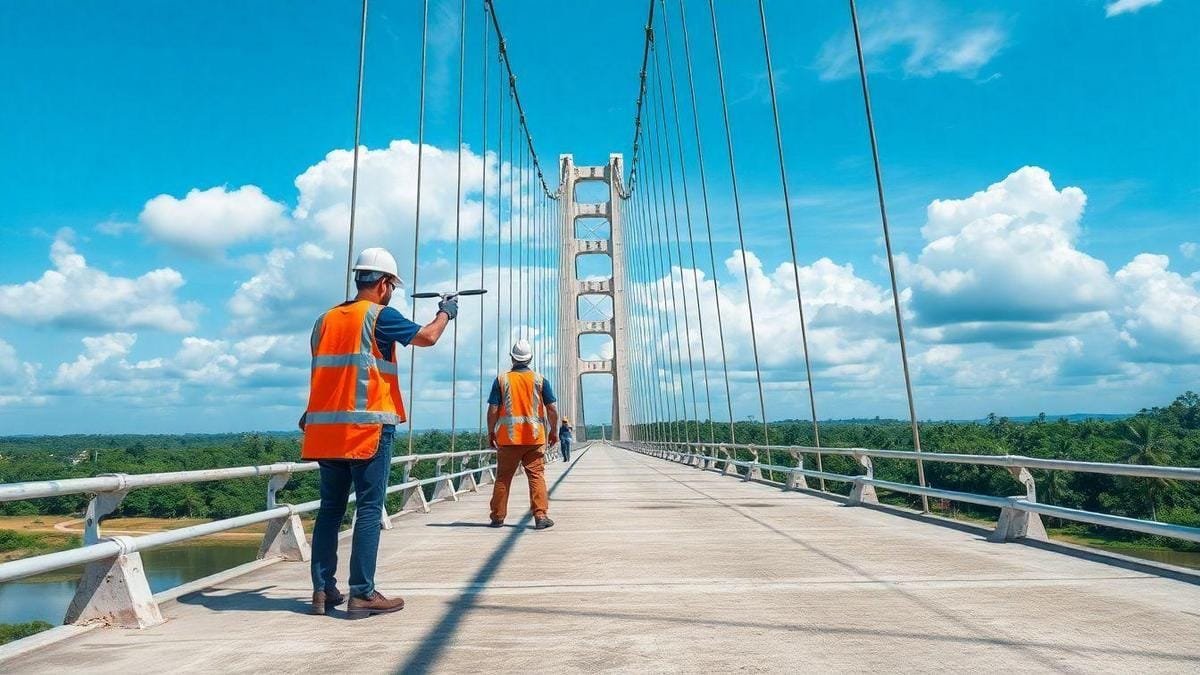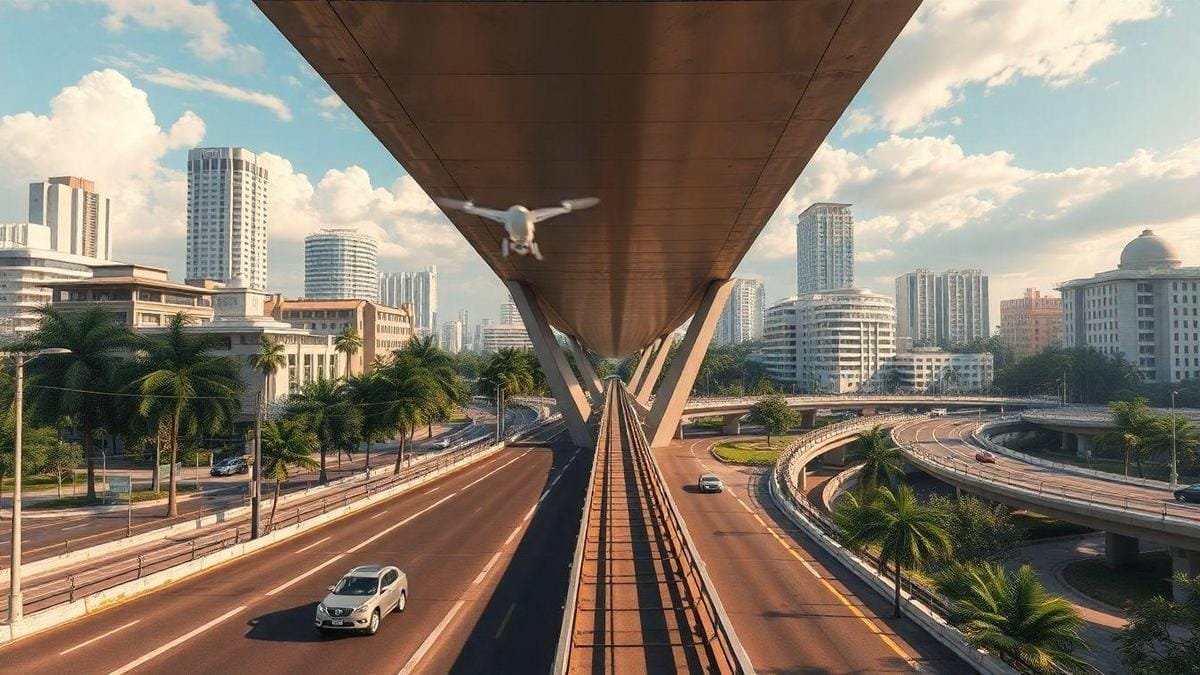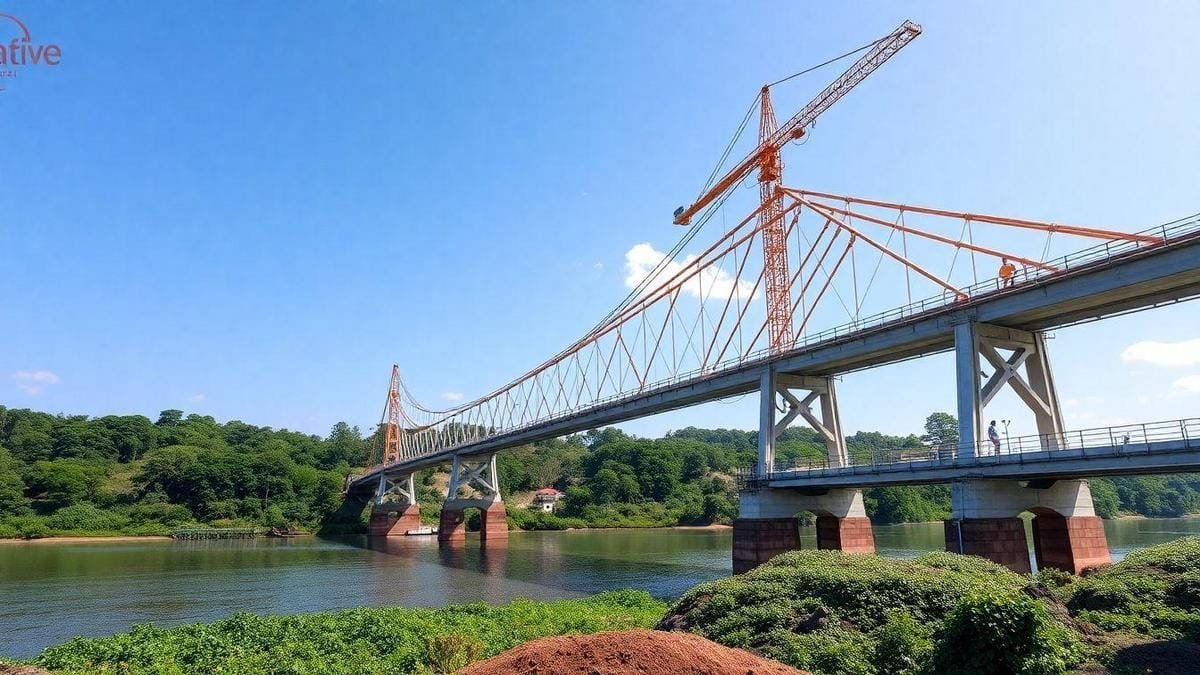Listen to this article
The technological innovations in bridge building in Brazil bring many challenges faced by engineers, but they also open doors to a future more connected. In this article, you'll find out how civil engineering has evolved with new technologies, what innovative materials are being used and how all this impacts our cities. Let's explore the climate challenges e financial that projects face, as well as knowing the smart bridges that are shaping the future of our infrastructure. Get ready to understand how these transformations are changing the way we move and connect!
Key learnings
- New technologies help build bridges faster.
- Modern materials make bridges stronger.
- Drones are used to monitor the construction.
- 3D printing is changing the way we make bridges.
- Sustainability is a priority in new construction.

The Role of Technological Innovations in Bridge Construction in Brazil
How Civil Engineering has evolved
A civil engineering in Brazil has taken a giant leap forward in recent decades. While bridges used to be made with simple materials and traditional methods, today we are seeing a scenario full of technological innovations in bridge building in Brazil. A striking example is the Octávio Frias de Oliveira cable-stayed bridgelocated in São Paulo. Inaugurated in 2008, this bridge stands out not only for its beauty, but also for the technology that supports it.
Examples of Innovative Materials
The choice of materials is crucial when building bridges. Let's take a look at some of them:
| Material | Description |
|---|---|
| High-strength concrete | Used to support large loads. |
| Carbon steel | Provides flexibility and resistance. |
| Reinforced Polymers | Lightweight and durable, ideal for complex structures. |
These materials not only make bridges more resistantbut they also help to reduce costs and construction time.
The Impact of New Technologies on Construction
The new technologies have a profound impact on bridge construction. The use of 3D modeling e computer simulations allows engineers to plan every detail before starting work. This helps avoid problems and optimize resources. In addition, techniques such as prefabricated speed up the process, allowing parts of the bridge to be built on one site and assembled on the final site.
The technological innovations in bridge building in Brazil face challenges, but they also bring benefits significant for society. With more modern bridgescities are becoming more connected, making it easier for people to get around. transportation and trade. This, in turn, improves people's quality of life.
Challenges Faced in the Construction of Bridges in Brazil
Climatic and Geographical Conditions
When we think about bridges of Brazil, such as the famous Rio-Niterói BridgeIn the end, we were reminded of the challenges posed by climatic and geographical conditions. Brazil has a variety of climates and terrains, which can complicate construction. For example, the humidity and intense rainfall of the Rio de Janeiro can delay the work and require special techniques to ensure the safety of the structure.
The mountainous areas and the wide rivers also need to be considered. The choice of location for the construction of the bridge is crucial. You need to ensure that the terrain is stable and that the bridge can withstand the environmental conditions.
Funding and Budget Problems
Another significant challenge is the financing. Projects often face budget cuts, which can delay or even cancel construction. For example, in the construction of the Guaíba BridgeIn Porto Alegre, there were financial difficulties that delayed the project.
The costs of materials and labor can also vary greatly. This calls for careful planning and efficient budget management. After all, every penny counts when it comes to building a bridge that will be used by thousands of people every day.
Overcoming Obstacles with Creativity
Despite these challenges, the creativity is a powerful tool. Engineers and architects have found ways to overcome the difficulties. The use of technological innovations in bridge building in Brazil has been a great ally. Technologies such as the use of sustainable materials e modular construction techniques have facilitated the process.
Here are some ways in which creativity has helped:
| Challenge | Creative Solution |
|---|---|
| Weather conditions | Use of moisture-resistant materials |
| Financing | Public-private partnerships to finance projects |
| Planning | Digital simulations to optimize the project |
These innovations not only help solve problems, but also bring benefits to society. Safer and more efficient bridges improve mobility and connect communities, bringing economic and social development.

Sustainability in Bridge Construction
Sustainable and ecological materials
When we talk about sustainability When building bridges, it is essential to consider the materials that we use. A notable example is São Paulo's cable-stayed bridge, which uses recycled concrete e high-strength steel. These materials are not only lighter, but also reduce the environmental impact. In addition, the choice of ecological paintings helps minimize pollution.
| Material | Advantages |
|---|---|
| Recycled concrete | Reduces waste and saves natural resources |
| High-strength steel | Less material needed, more durability |
| Ecological paintings | Less pollution and more safety for the environment |
Environmentally friendly projects
Infrastructure projects, such as the Rio-Niterói Bridgewere planned with a vision of respect for the environment. The team of architects and engineers took care to preserve the fauna and flora sites during construction. They used techniques that minimize interference in nature, such as the use of low emission machines.
Benefits of Sustainability in Infrastructure
Sustainability brings many benefits for society. Here are some of them:
- Reducing costsSustainable materials can be cheaper in the long run.
- Improved quality of lifeCleaner and healthier environments.
- Valuing the region: Sustainable projects attract more visitors and investment.
A inclusion of technological innovations in bridge construction in Brazil also brings challenges facedBut the benefit of a greener future is worth it.
Smart Bridges: The Future of Engineering
What are Smart Bridges?
The smart bridges are structures that use advanced technology to improve safety, durability and efficiency. They are designed to collect data in real time, monitoring the state of the bridge and traffic conditions. Imagine a bridge that "talks" to engineers, alerting them to problems before they become major. That's what makes these bridges so special!
Technologies that Make Bridges More Efficient
The technological innovations in bridge building in Brazil have been impressive. Let's take a look at some of these technologies:
| Technology | Description |
|---|---|
| Monitoring sensors | Devices that collect data on the use and condition of the bridge. |
| Sustainable materials | Use of recycled concrete and steel to reduce environmental impact. |
| Control Systems | Software that analyzes data and suggests necessary maintenance. |
These technologies not only improve safety, but also extend the lifespan of bridges, saving society money and time.
The Importance of Innovation for Urban Mobility
Innovation is crucial to improving urban mobility. When we talk about bridges, these structures connect communities and facilitate transportation. A clear example is the São Paulo's cable-stayed bridge. With a modern architectural design, it is not only beautiful, but also efficient. Construction took around 3 years and used state-of-the-art engineering techniques.
With smart bridges, you can expect less congestion and more safety on the roads. The technological innovations in bridge building in Brazil face challenges, but the benefits are undeniable. They help make cities more connected and accessible for everyone.

Examples of Great Bridges in Brazil
The Rio-Niterói Bridge and Its Challenges
A Rio-Niterói Bridge is one of the most iconic in Brazil. Inaugurated in 1974, it connects the cities of Rio de Janeiro and Niterói, crossing Guanabara Bay. The project, signed by architect Eurico Gaspar Dutrawas a response to the need to improve traffic between these two cities.
Construction details:
- Construction time: 4 years
- Construction methodWe used the precast beamsThis made it easier to assemble the structures.
- Technology used: The bridge was one of the first to use engineering techniques advanced for the time, including the analysis of vibrations e stress.
The challenges faced during construction were many. The weather conditions and the depth of the bay made the work complicated. But in the end, the bridge brought significant benefits for society, reducing travel times and increasing trade between cities.
The Guaíba Bridge and Its Innovations
Another major project is the Guaíba BridgeThe bridge connects Porto Alegre to Guaíba. Inaugurated in 2020, this bridge is an example of technological innovations in bridge building in Brazil.
Construction details:
| Aspect | Information |
|---|---|
| Construction time | 3 years |
| Construction method | Structure of reinforced concrete |
| Technology used | Monitoring systems in real time |
The bridge was designed to withstand extreme weather conditions and allow vehicle and pedestrian traffic. The innovations employed ensured that the structure was resistant e durable. In addition, the project took into account the sustainabilitywith green areas and walkways for cyclists.
How These Works Have Transformed Cities
These great bridges are not just concrete and steel structures; they are transform people's lives. The Rio-Niterói Bridge has facilitated the daily commute of thousands of workers, while the Guaíba Bridge has improved access to services and commerce.
Both works reduced travel timeThe bridges are also symbols of the region's economic and social development. Bridges have also become symbols of progress e unitconnecting people and communities.
The Planning Process in Bridge Construction
Stages of Planning and Execution
When you think about building a bridge, planning is key. Let's use the Rio-Niterói Bridgeone of the most famous in Brazil. The planning began with the site analysis and traffic study. The steps were:
- Feasibility Study: Assess whether the bridge was really necessary.
- Architectural design: Create a design that is both functional and beautiful.
- Licensing: Obtain the necessary permissions for construction.
- Execution: Start building according to plan.
The construction of the Rio-Niterói Bridge took around 4 yearsfrom 1968 to 1974. During this time, several technologies were used, such as the use of precast concrete e engineering techniques which ensured the safety of the structure.
Importance of Research and Development
Research is fundamental to this process. Before construction began, studies were carried out on the weather conditions and soil. This helped avoid future problems. For example, the choice of corrosion-resistant materials was crucial, as the bridge is exposed to sea air.
A technology also played an important role. The use of new construction methods, such as the piling techniqueThis has made the bridge stronger and more durable. These advances are essential for meeting the challenges that arise during construction.
How Good Planning Ensures Success
Good planning is like a road map. Without it, you can get lost. In the case of the Rio-Niterói Bridge, meticulous planning ensured that the work was completed on time and within budget. What's more, the bridge has brought many benefits:
- Ease of transportation: Reduced travel time between Rio and Niterói.
- Economic DevelopmentTrade and movement of people increased.
- Social IntegrationFacilitated access to services and opportunities.

Construction Technologies that are Changing Brazil
3D Printing in Bridge Construction
A 3D printing is revolutionizing the way we build bridges in Brazil. One notable example is Golden River Bridgewhich was built using this innovative technology. The project was chosen because it is a fast and efficient solution for connecting isolated communities.
O construction process involved printing structural elements in modules, which sped up the completion time. The bridge was erected in just three monthsAn impressive feat considering traditional methods can take years.
The planning stages included:
- Site analysisChoose a location that is easily accessible and meets local demand.
- Project development: Use 3D modeling software to ensure accuracy.
- Printing the modules: Produce the parts on a large-scale 3D printer.
- Assembly: Assemble the printed modules on site.
The technology used not only reduced costsbut also minimized waste of materials. In addition, the bridge has brought significant benefits to society, such as better access to services and greater safety for residents.
Using Drones to Monitor Construction Sites
The drones are becoming an indispensable tool in the construction industry. They enable efficient monitoring of construction sites, such as the São Paulo's New Subway Line. This line is an example of how technology can facilitate the management of large projects.
Drones are used for
- Visual inspection: Check the progress of the work without having to climb structures.
- MappingCreate detailed maps of the land and building.
- Real-time monitoring: Monitor progress and identify problems quickly.
With this technology, the response time for project adjustments is much faster. This helps to avoid delays and extra costs, a real relief for managers.
The Future of Construction with Advanced Technologies
The future of construction in Brazil looks promising with the incorporation of advanced technologies. Technological innovations in bridge building in Brazil and the challenges faced are being overcome with creativity and efficiency. The combination of 3D printing and drones is just the beginning.
Other technologies, such as artificial intelligence e augmented realitynew technologies are emerging to further improve the planning and execution of projects. This means that construction work will not only be faster, but also safer and more sustainable.
Social Benefits of Bridge Innovations
Improving Urban Mobility
When we talk about technological innovations in bridge building in BrazilA striking example is the São Paulo's cable-stayed bridge. This bridge is not only an architectural icon, but also a watershed in the city's urban mobility. With a bold design by Santiago CalatravaThe bridge was inaugurated in 2008 and connects the south and west sides of São Paulo.
The choice of location was strategic. The bridge was designed to facilitate traffic in an area that previously faced heavy congestion. The use of advanced technology in the construction, such as high-strength steel cables, ensured that the structure could support the weight of the vehicles and still offer safety to pedestrians.
Access to New Economic Opportunities
The construction of the cable-stayed bridge brought economic benefits significant. With improved mobility, access to new job opportunities increased. Companies began to set up in the surrounding areas, taking advantage of the ease of transportation. This generated a cascade effect, where more people were able to commute to work, and more businesses were created.
How Bridges Transform Communities
Bridges, such as the Estaiada, play a fundamental role in transforming communities. They don't just connect places, they also connect people. Think of how many lives have been positively impacted. By reducing commuting time, people can spend more time with their families and less time in traffic jams.
| Benefits of the cable-stayed bridge | Description |
|---|---|
| Increased Mobility | Reduced travel time. |
| Economic Development | New companies and jobs. |
| Social Integration | Improved quality of life. |
A Ponte Estaiada is a perfect example of how innovation in bridge building can bring about significant changes. Facing the challengesIn addition, technology and careful planning, such as heavy traffic and the need for safety, made all the difference.

The Impact of Technological Innovations on Brazilian Infrastructure
The Importance of Modernizing Structures
When we think about technological innovations in bridge building in BrazilIt's impossible not to remember Guaíba Bridgein Porto Alegre. This bridge is not just a concrete structure; it is a symbol of modernization and the connection between people. Modernizing structures is vital to improving urban mobility and ensuring that cities grow in a sustainable way.
The Guaíba Bridge was designed to withstand a large flow of vehicles and pedestrians, guaranteeing safety and efficiency. The project involved a meticulous planningIt's a process that has taken into account traffic, the environment and the needs of the population. By modernizing structures, you not only improve the infrastructure, but also boosts the local economy.
Examples of Success in Infrastructure Projects
The Guaíba Bridge is a successful example of how technology can transform infrastructure. Here are some points that highlight the importance of this work:
| Aspect | Details |
|---|---|
| Choice of location | Connecting Porto Alegre to neighboring cities. |
| Architecture Project | Modern and functional design. |
| Construction method | Use of advanced engineering techniques. |
| Construction time | Approximately 4 years. |
| Planning stages | Impact study, approval and execution. |
| Technology used | Sustainable materials and monitoring systems. |
| Benefits generated | Improved traffic and access to services. |
The Road to a More Connected Brazil
With the construction of works such as the Guaíba Bridge, we are moving towards a more connected Brazil. These innovations not only make it easier to get around, but also promote the social integration. When you have a bridge that connects different regions, you are creating opportunities.
The technological innovations in bridge building in Brazil face challenges, such as the need to guarantee the safety and durability of structures. However, with advances in technology, these challenges can be overcome.
The Guaíba Bridge is an example of how technology and proper planning can make a difference. With each new construction project, we are getting closer to a future where cities are more accessible and people's lives are made easier.
Conclusion
In short, the technological innovations in bridge building in Brazil are shaping a more connected e sustainable. The evolution of civil engineering brings with it not only challenges, but also a opportunity to transform urban infrastructure. With the use of innovative materials, 3D printing, e droneswe are building bridges that not only connect places, but also transform lives.
These structures are more than just passageways; they are symbols of progress, social integration e economic development. When facing climate and financial challenges, creativity and technology become powerful allies. So as you contemplate the future of construction, remember: every bridge erected is a step towards a more sustainable Brazil. accessible e efficient.
If you're curious and want to know more about how these innovations are impacting our society, be sure to check out the other articles at Renovation Tips.
Frequently asked questions
What are the technological innovations in bridge building in Brazil?
Innovations include the use of sustainable materials, 3D printing and intelligent monitoring systems. These methods make construction faster and safer.
What are the challenges faced in building bridges in Brazil?
Challenges include a lack of resources, adverse weather conditions and the need for advanced technology. This can delay projects.
How do technologies affect the cost of construction work?
Technologies can reduce costs in the long term, but initial investments can be high. Implementing new systems will pay off in the future.
What innovative materials are being used?
New composites, lightweight steel and sustainable concrete are being used. They are more durable and reduce the environmental impact.
How does 3D printing help build bridges?
3D printing makes it possible to build parts of the bridge quickly. This saves time and reduces waste.
What is intelligent monitoring?
It's the use of sensors to monitor the health of the bridge. This helps detect problems before they become serious.
Are there any examples of innovative bridges in Brazil?
Yes, the cable-stayed bridge in São Paulo is a great example. It uses many modern technologies.
What are the benefits of using drones in construction?
Drones help to monitor and inspect hard-to-reach places. They provide images in real time.
How can technology improve safety on construction sites?
Digital security systems and drones increase safety. This reduces accidents during construction.
What are the future trends in bridge construction?
We expect more automation, use of AI and green technologies. The future promises to be more efficient and sustainable.
Are technological innovations accessible to all companies?
Accessibility varies. Larger companies generally invest more. But there are solutions for small businesses too.
How does the training of professionals adapt to these innovations?
Technical courses and universities are updating their curricula. This prepares students for a changing market.
What should managers consider when implementing these technologies?
Cost management, training and maintenance are crucial. They must be carefully planned to ensure the success of the project.

I'm passionate about sharing the fascinating world of engineering. In this blog, we'll embark on a journey through innovative projects, cutting-edge technologies and the challenges of construction. If you're an enthusiast, a student or just curious about how things are built, this is the place for you! Get ready to uncover the secrets behind bridges, buildings, tunnels and other engineering marvels.

